Crassula badspoortensis
Crassula badspoortensis Van Jaarsv.
Family: Crassulaceae
Common names: cliff sosatie-crassula (Eng.), krans-sosatie, krans-inryger (Afr.)
Introduction
Crassula badspoortensis is a rare, sparingly branched succulent shrublet becoming a cliff-hanger, with stems up to 400 mm long, greyish-green, disc-like leaves that are fused and a short, rounded inflorescence of small, star-shaped, whitish flowers in summer. Plants are known from south-facing cliffs near Calitzdorp and De Doorns in the Klein Karoo.
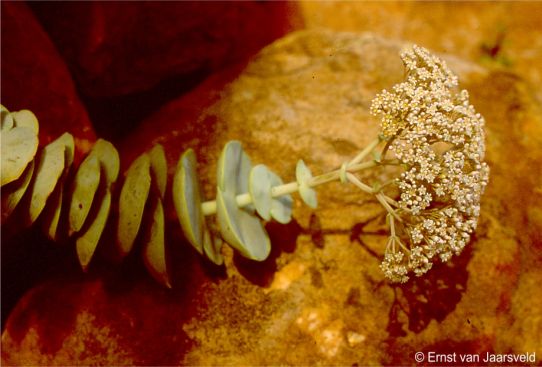
Fig. 1. Crassula badspoortensis in flower in cultivation in the Succulent Collection at Kirstenbosch National Botanical Garden, specimen collected at Badspoort near Calitzdorp, Klein Karoo, Western Cape.
Description
Description
Spreading, sparsely branched (3–8 branches) shrublets, up to 100 mm high, up to 400 mm in diameter. Stems 3–4 mm in diameter, spreading, becoming pendulous; internodes 6–10 mm long. Leaves sessile, broadly ovate, 20–35 ´ 20–35 mm, flat to slightly biconvex, spreading at right angles but slightly ascending and forwardly curved; apex subacute; bases fused, amplexicaul, forming a sheath; surface smooth, glaucous to whitish green; margins entire; hydathodes concentrated towards margins. Inflorescence a short, rounded thyrse, up to 40 mm long, up to 65 mm in diameter, with many 5-merous, pedicellate flowers in dichasia; peduncle indistinct owing to gradual transition to bracts; basal bracts 8 ´ 5 mm, becoming smaller (2 ´ 1 mm) on inflorescence, triangular ovate. Flowers star-shaped, up to 4.5 mm in diameter, white; pedicels 2–5 mm long. Calyx lobes triangular, 1.3 ´ 0.8 mm, apices acute. Corolla lobes lorate-lanceolate, 3.5 ´ 1.0 mm, recurved, apices obtuse to subacute. Stamens: filaments 2 mm long; anthers 0.2 mm long, dark maroon; pollen yellow. Squamae truncate, 0.3 mm in diameter, 0.2 mm high, thick, fleshy, yellowish orange. Carpels 2 mm long; ovary bottle-shaped, tapering into short, outward pointing style, inner side of ovary asperulous. Flowering time is in summer and autumn (January–March).
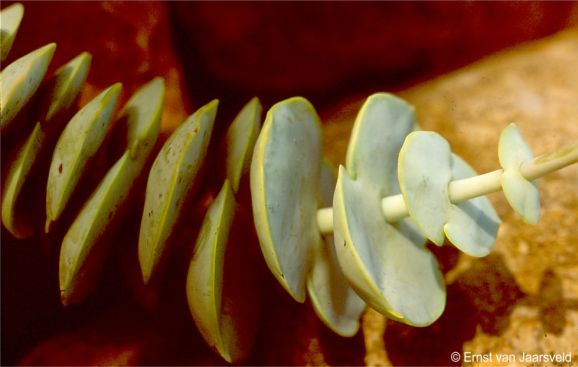
Fig. 2. A close-up of the stem and leaves of Crassula badspoortensis, from a cultivated specimen at Kirstenbosch, ex Badspoort near Calitzdorp, Klein Karoo, Western Cape.
Conservation Status
Status
Assessed as Rare by the Red List of South African Plants, Crassula badspoortensis has a small natural range and is not common locally, but is well protected by its inaccessible cliff habitat and is not threatened.
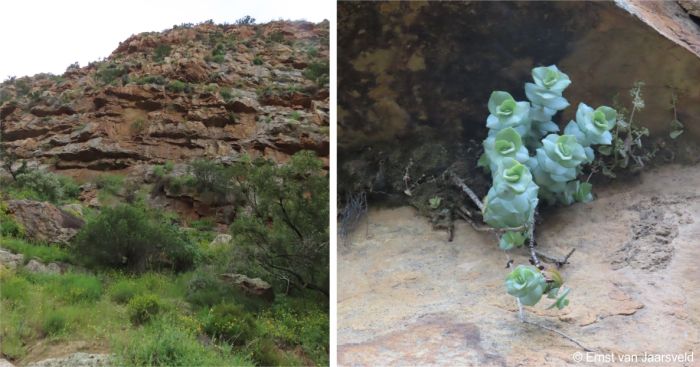
Fig. 3. The south-facing cliffs at Badspoort, near Calitzdorp in the Western Cape, habitat of Crassula badspoortensis, with a close-up of a young Crassula badspoortensis plant on the cliff.
Distribution and habitat
Distribution description
Crassula badspoortensis is widely distributed in the western Klein Karoo, from Badspoort on the Olifants River, west of Oudtshoorn, in the east to Keurkloof near De Doorns, Hex River Valley, in the west, from 500–800 m altitude. It is an obligatory cliff dweller, growing on south-facing quartzitic sandstone cliffs. Plants are firmly rooted in crevices. It is locally abundant to less prominent. Temperature moderate to high in summer and can reach 40°C. Winters are cooler but frost is absent. The average daily maximum temperature is 25–26°C and the average daily minimum for the region 9–10°C. Rainfall in winter (cyclonic) and summer (thunder showers), ranging from 250–350 mm per annum.
At Badspoort, plants grow in Western Gwarrieveld, Succulent Karoo Biome. The associated cliff-dwelling succulents include Crassula cotyledonis, Crassula muscosa, Crassula perforata, Haemanthus coccineus, Haworthia blackburniae, Haworthia mucronata var. rycroftiana, Lampranthus affinis, Curio muirii, Drimia uniflora (= Litanthus pusillus) and Tylecodon leucothrix. The geology at Badspoort consists of quartzitic sandstone of the Peninsula Formation, Table Mountain Group (Cape Supergroup). At Keurkloof near De Doorns associated cliff dwellers include: Aloe perfoliata, Crassula atropurpurea var. anomala, Crassula nemorosa, Crassula rupestris, Crassula perforata, Crassula orbicularis, Crassothonna cacalioides (= Othonna carnosa), Haemanthus coccineus, Nerine ridleyi, Tylecodon paniculatus and Oxalis pocockiae.
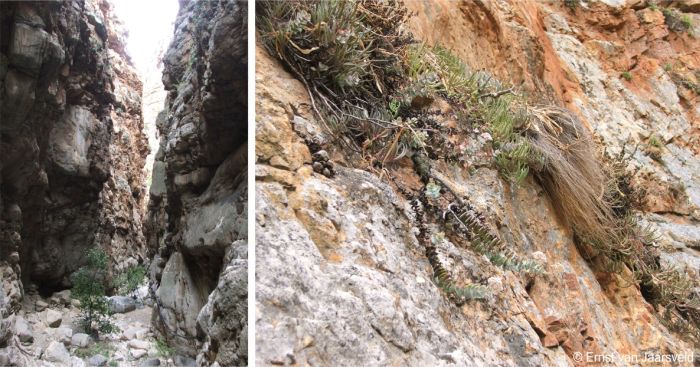
Fig. 4. The sheer, shady cliffs at Keurkloof near De Doorns, Western Cape, habitat of Crassula badspoortensis, and a close-up of Crassula badspoortensis growing with Crassothonna cacalioides (= Othonna carnosa) and Crassula orbicularis on the cliff.
Derivation of name and historical aspects
History
Crassula badspoortensis was named by the author in the magazine Aloe in 2001. It is named after its native habitat, Badspoort in the Little Karoo, where the plant was first found. Although originally named Crassula badspoortense, the gender of the epithet was corrected to conform with the feminine genus name. The botanical artist Tamlin Blake did an illustration of the plant, also depicted here. Crassula badspoortensis belongs to section Perfilatae to which 6 species belong. These include: Crassula badspoortensis, C. fusca, C. sladenii, C. rupestris, C. brevifolia and the largest of them all C. macowaniana. Adrian Haworth, British succulent botanist, created this section in 1828 to accommodate those species with woody stems and leaves with obvolute vernation (leaves folded together in bud with the margin of one leaf overlapping that of the leaf opposite), a pedunculate inflorescence and small tubular flowers. Plants in section Perfilatae are popular among succulent enthusiasts due to the ornamental appeal of their leaves. Of these species Crassula badspoortensis, C. sladenii, and C. rupestris subsp. marnieriana are mostly obligatory cliff-dwellers.
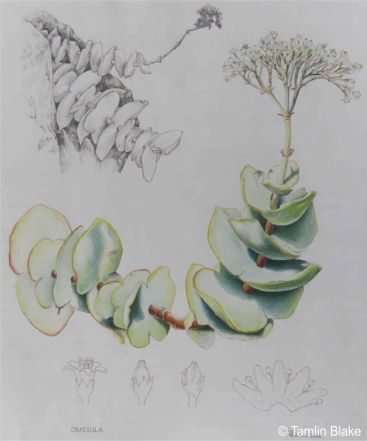
Fig. 5. An illustration by Tamlin Blake of the type specimen of Crassula badspoortensis, collected at Badspoort, Calitzorp in the Klein Karoo, Western Cape, South Africa.
Ecology
Ecology
Crassula badspoortensis is a little-branched, long-lived perennial with a spreading to drooping habit, sometimes hanging from the cliff face. The stems are flexible at first, becoming shorter and pendulous or subpendulous. The softer, less woody and pendulous nature of the stems can be viewed as an adaptation to the cliff environment. The leaves are succulent, fused into opposite discs, an adaptation to xeric conditions of the cliff face. The leaf epidermis is whitish, grey-green to glaucous (covered with powdery bloom), an adaptation resulting from the extreme run-off in the sheer habitat. The leaves are persistent and long-lived, an adaptation to the xeric cliff conditions. The inflorescence is a large, round-topped thyrse, conspicuous, from midsummer to autumn (November–April), diurnal. The follicles are dehiscent, with seeds spontaneously released and dispersed by wind during autumn rains, maximising establishment.
The vigorous, spreading growth ensures vegetative increase and branches will occupy new crevices by active growth. The stems may develop aerial roots. A branch blown from a cliff face and landing in a crevice, will root. This vegetative increase is an effective backup growth strategy ensuring long-term survival on the cliff.
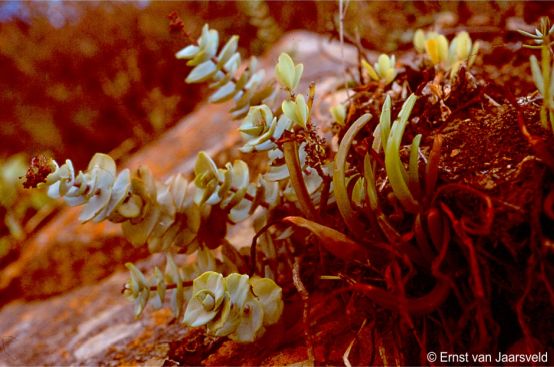
Fig. 6. Crassula badspoortensis in habitat with Haworthia blackburniae and Curio muirii at Badspoort, near Calitzdorp, Western Cape.
Uses
Use
It is not known whether the plants are used medicinally.
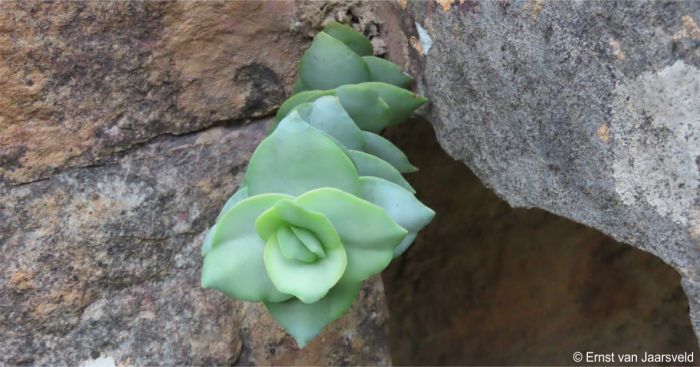
Fig. 7. A close-up of a young Crassula badspoortensis plant on a cliff at Badspoort near Calitzdorp, Klein Karoo, Western Cape.
Growing Crassula badspoortensis
Grow
Although Crassula badspoortensis is not well-known in cultivation, it is fairly easy to grow and makes a beautiful potplant. Best for succulent gardens, thicket or succulent karoo gardens, grown in rockeries or on embankments, or outside of its native habitat in containers grown under controlled conditions in a greenhouse. Grow in light shade or dappled shade. Soil should be sandy and slightly acidic and well-drained. Add ample compost or feed with a liquid organic fertiliser. Water well, but allow plants to dry out for some time before watering again. The stored moisture in their leaves and stems allow succulents to survive when no soil moisture is present.
Crassula badspoortensis can be propagated from cuttings or seed. Best propagated by cuttings taken during spring and summer. Plant cuttings of 8-12 cm length in a sandy soil. The roots sometimes can be affected by mealybug and treat accordingly. Seed is fine and can be sown in a sandy mixture in autumn, cover with a very thin layer of gravel. Keep moist. Transplant seedlings as soon they are large enough to handle.
References
- Christenhusz, M.J.M., Fay, M.F. & Chase, M.W. 2017. Plants of the World, an illustrated Encyclopedia of vascular plants. Kew Publishing, Royal Botanic Gardens, Kew.
- Eckel, P.M. 2010-2023. A grammatical dictionary of botanical Latin. Online. http://www.mobot.org/mobot/latindict/introduction.shtml.
- Eggli, U. (ed.) 2003. Illustrated handbook of succulent plants: Crassulaceae. Springer, Berlin.
- Mucina, L. & Rutherford, M.C. (eds) 2006. The vegetation of South Africa, Lesotho and Swaziland. Strelitzia 19. South African National Biodiversity Institute, Pretoria.
- Raimondo, D., Von Staden, L., Foden, W., Victor, J.E., Helme, N.A., Turner, R.C., Kamundi, D.A. & Manyama, P.A. (eds) 2009. Red list of South African plants. Strelitzia 25. South African National Biodiversity Institute, Pretoria.
- Rowley, G. 2003. Crassula: a growers guide. Cactus & Co. Vista, California.
- Toelken, H.R. 1985. Crassulaceae. Flora of Southern Africa 14: 1–244.
- Van Jaarsveld, E.J. & Van Wyk, A.E. 1999. Five new cremnophilous taxa from semi-arid regions in South Africa. Aloe 36 (4): 71–74).
- Van Jaarsveld, E.J. & Van Wyk, A.E. 2001. Crassula badspoortense, a new species from the Western Cape Province. Aloe 38:29–30.
Credits
Ernst van Jaarsveld
Kirstenbosch National Botanical Garden (Retired)
Babylonstoren Farm (Current)
Extraordinary senior lecturer and researcher,
Department of Biodiversity and Conservation, University of the Western Cape
August 2024
Plant Attributes:
Plant Type: Succulent
SA Distribution: Western Cape
Soil type: Sandy, Loam
Flowering season: Late Summer, Autumn
PH: Acid, Neutral
Flower colour: White
Aspect: Shade, Morning Sun (Semi Shade), Afternoon Sun (Semi Shade)
Gardening skill: Average
Special Features:
Horticultural zones










Rate this article
Article well written and informative
Rate this plant
Is this an interesting plant?
Login to add your Comment
Back to topNot registered yet? Click here to register.